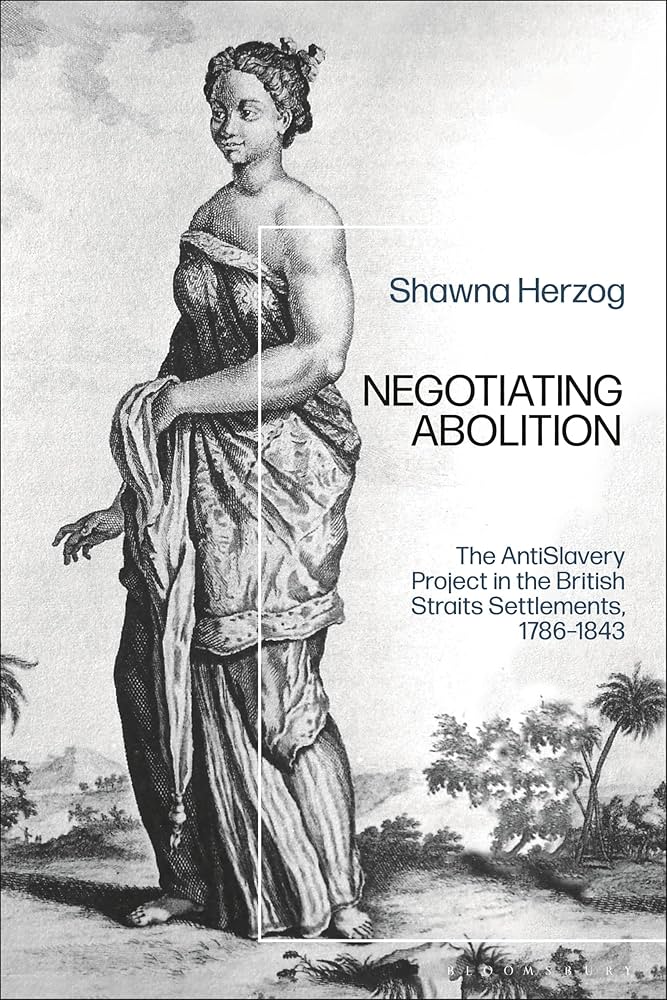
Title: Negotiating Abolition: The Antislavery Project in the British Straits Settlements, 1786-1843
Author: Shawna Herzog
Publisher: Bloomsbury Academic, 2021
To address the dearth of scholarly literature on abolitionism in the Straits Settlements, Shawna Herzog wrote Negotiating Abolition using studies on British imperialism and the Indian Ocean World. This study examines the challenges of abolition on the Malay Peninsula and the hesitancy of British East India Company officials to enforce strictly the ideals of the anti-slavery movement that permeated parts of British officialdom. While there have been some previous scholarly works on the topics of human trafficking, smuggling, slavery, and capitalism, few have examined the topic of abolition in the Straits Settlements in such detail as Herzog.
Herzog argues that the desire to protect private property, the overall weakness of colonial authority in the region, and a series of legal disputes prolonged and complicated the East India Company’s efforts to abolish slavery in the Straits Settlements. She also examines how the roles of biased perceptions based on race and gender within British officialdom inhibited the effectiveness of the anti-slavery movement, particularly in regard to engendered concepts of domestic service and labor within these settlements. There also remained the issue that women trafficked to the colonies became wives or concubines, whose status was difficult for colonial officials to define legally.
The work’s strongest attributes are the impressive fusion of primary and secondary source research on the topic. Herzog’s expansive reading and understanding of the history of slavery, gender, orientalism, and so forth within the Indian Ocean World, Southeast Asian history, and beyond to even the Atlantic World is commendable. The work incorporates a wide variety of authors and topics that contextualize the abolitionist movement within the Indian Ocean World. The primary sources mainly revolve around East India Company documents collected from the British Library and British National Archives such as factory records and correspondences. However, the most valuable records employed in this search are documents related to the East India slave trade compiled by the British Foreign Office, which detailed experiences endured by those held in bondage within the Straits Settlements prior to 1841. Few other works on this topic so seamlessly weave the primary and secondary sources into such a coherent narrative.

However, the greatest weakness within this work are contradictions with commonly accepted history and some lack of clarity. The most prominent example is the common misconception that the East India Company annexed Singapore in 1819. This is false as the company only fully annexed Singapore from the sultan and temenggung in 1824 after the failure of the co-governing partnership between their three factions. This shortcoming undermines the work’s narrative because it prominently places Raffles’ stated determination to eliminate the slave trade in Singapore as a key moment in Singapore’s history but does not properly frame the political context at the time. Another example is the implication that Sultan Mahmud Shah of Malacca fled to form the settlement of Banda Aceh after the fall of Malacca in 1511 to the Portuguese, which was not the case. 1 While some errors can be overlooked, these are quite serious. Also, the work could have given a clearer reason for Malacca’s prominence within the book’s case other than that the primary sources focus on slavery in that township because it was a significantly less important port city by the mid-19th century in comparison to Singapore or Penang.
Given the importance of slavery and other unfree labor systems within Southeast Asia during the early 19th century, East India Company officials had a great deal of difficulty in determining who belonged to which specific category to eliminate slavery because it challenged their own hold on power that required the support of slaveholders. Important company officials hesitated to challenge the property claims of the established elites who propped up British regional power. To make matters worse for the more fervent abolitionists, the legal codes were quite unclear within the East Indies, which made it harder to emancipate unfree individuals. British colonial authorities lacked the resources or clear legal mandate to eliminate slavery effectively. These circumstances made the biases of colonial officials much less relevant because they lacked the power or ability to implement abolition quickly and effectively within the Straits Settlements.
Overall, Herzog’s work has strong analysis and contextualizes abolitionism well within the historiography, but weaknesses concerning the overall historical context will require the reader to have prior knowledge on the subject. There is still certainly room for future scholarship on this topic as Herzog largely focuses on Malacca’s struggle in determining how to proceed with abolition such as focusing more on trafficking or slavery in other places within the Malay Peninsula and beyond. The work’s acceptance of the limitations on British colonial power places it in line with more recent studies on the subject. Herzog’s central argument is quite persuasive and scholars should be mindful of these limitations when tackling this subject.
Review by Scott Abel
Scott Abel is affiliated with Union County College as an instructor and Kean University as a research specialist.
Reference
McRoberts, R. W. “An Examination of the Fall of Melaka in 1511.” Journal of the Malaysian Branch of the Royal Asiatic Society 57, no. 1 (1984), 26-39.
Notes:
- R. W. McRoberts, “An Examination of the Fall of Melaka in 1511.” Journal of the Malaysian Branch of the Royal Asiatic Society 57, no. 1 (1984), 37-38. ↩
